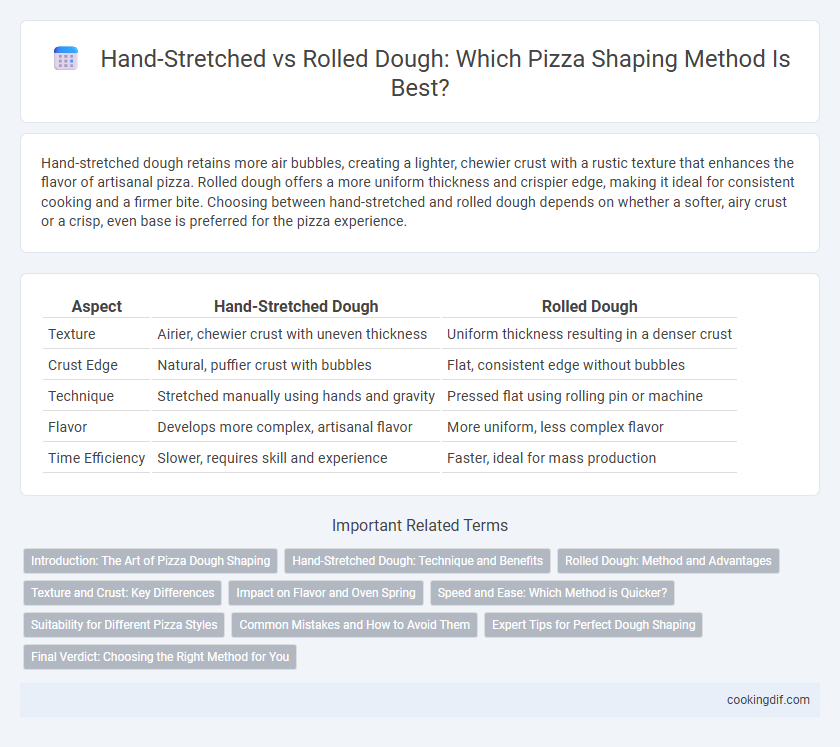Hand-stretched dough retains more air bubbles, creating a lighter, chewier crust with a rustic texture that enhances the flavor of artisanal pizza. Rolled dough offers a more uniform thickness and crispier edge, making it ideal for consistent cooking and a firmer bite. Choosing between hand-stretched and rolled dough depends on whether a softer, airy crust or a crisp, even base is preferred for the pizza experience.
Table of Comparison
| Aspect | Hand-Stretched Dough | Rolled Dough |
|---|---|---|
| Texture | Airier, chewier crust with uneven thickness | Uniform thickness resulting in a denser crust |
| Crust Edge | Natural, puffier crust with bubbles | Flat, consistent edge without bubbles |
| Technique | Stretched manually using hands and gravity | Pressed flat using rolling pin or machine |
| Flavor | Develops more complex, artisanal flavor | More uniform, less complex flavor |
| Time Efficiency | Slower, requires skill and experience | Faster, ideal for mass production |
Introduction: The Art of Pizza Dough Shaping
Hand-stretched dough preserves the gluten network, creating a light, airy crust with irregular bubbles favored in traditional Neapolitan pizza. Rolled dough produces a uniform thickness and a denser, crispier crust, common in New York-style pizza. Choosing between hand-stretched and rolled methods impacts texture, flavor, and overall pizza quality.
Hand-Stretched Dough: Technique and Benefits
Hand-stretched dough involves gently pulling and rotating the dough by hand to achieve an even thickness and a light, airy crust. This technique preserves the dough's gas bubbles, resulting in a chewier texture and better rise during baking compared to rolled dough. Artisanal pizzerias favor hand-stretching for its ability to create unique crust variations and enhance overall flavor and texture.
Rolled Dough: Method and Advantages
Rolled dough shaping involves using a rolling pin to flatten pizza dough into an even, thin layer, which ensures consistent thickness and uniform cooking. This method offers greater control over dough size and shape, making it ideal for achieving a perfectly round pizza base with a crispier crust. Rolled dough is particularly advantageous in commercial settings where speed and replication of dough dimensions are essential.
Texture and Crust: Key Differences
Hand-stretched pizza dough creates an uneven thickness that promotes a light, airy crust with crisp edges and a chewy center, thanks to preserved gas bubbles during stretching. Rolled dough tends to produce a denser, more uniform crust texture due to the even pressure applied by the rolling pin, which can compress air pockets and reduce chewiness. The choice between hand-stretching and rolling directly affects the pizza's texture, with hand-stretched dough offering a more artisanal, rustic bite and rolled dough delivering consistency and ease of shaping.
Impact on Flavor and Oven Spring
Hand-stretched dough preserves the gluten structure better, leading to a chewier texture and enhanced oven spring, which creates a light, airy crust with well-developed flavor. Rolled dough compresses the gluten strands, resulting in a denser, less elastic crust that may hinder oven spring and reduce the depth of flavor. The stretching method significantly affects the dough's gas retention and caramelization, key factors in achieving an optimal pizza crust.
Speed and Ease: Which Method is Quicker?
Hand-stretched dough offers greater speed and flexibility, as it requires less equipment and allows for immediate shaping by feeling the dough's texture. Rolled dough, while providing uniform thickness, demands additional tools and preparation time, which can slow down the overall process. For quick pizza preparation, hand-stretching is typically the faster and easier method preferred by experienced pizzaiolos.
Suitability for Different Pizza Styles
Hand-stretched dough offers a light, airy texture ideal for Neapolitan and traditional Italian pizzas, allowing for uneven thickness and a chewy crust. Rolled dough provides uniform thickness, making it suitable for New York-style and thin-crust pizzas that require a consistent base for even toppings and crispiness. Each method affects the final pizza's texture and structural integrity, influencing the overall eating experience.
Common Mistakes and How to Avoid Them
Hand-stretched dough often suffers from uneven thickness and tearing due to insufficient gluten development or aggressive pulling, while rolled dough can become too dense, losing its airy texture and flavor. Common mistakes include overworking the dough when hand-stretching, leading to tough crusts, and using excessive pressure with a rolling pin that compresses air bubbles essential for a light crust. To avoid these pitfalls, allow the dough to rest adequately for elasticity, gently stretch with fingertips in a circular motion, and limit rolling pin use to preserve the dough's natural rise and chewy consistency.
Expert Tips for Perfect Dough Shaping
Hand-stretched dough preserves the gluten network, resulting in a chewier crust with natural air bubbles, while rolled dough yields a uniform thickness but can compress the dough, reducing texture. Expert tips recommend gently stretching the dough with fingertips to retain elasticity and avoid overworking it, which prevents toughness. Using a light dusting of flour during hand-stretching minimizes sticking without drying the dough, ensuring optimal rise and a perfect pizza base.
Final Verdict: Choosing the Right Method for You
Hand-stretched dough offers a more artisanal texture with irregular air pockets, ideal for achieving a light, chewy crust favored in Neapolitan-style pizzas. Rolled dough provides a uniformly thin and consistent base, perfect for crispier textures typical of New York-style slices. Selecting between hand-stretched and rolled methods hinges on your desired crust texture and pizza style preferences.
Hand-stretched vs Rolled for dough shaping Infographic

 cookingdif.com
cookingdif.com